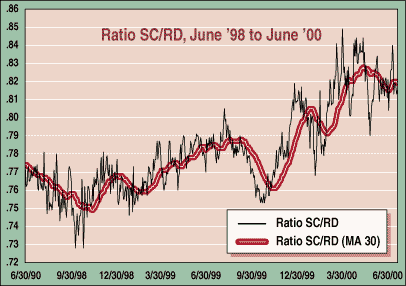TRADING TECHNIQUES
Exploiting Closely Related Stocks
Pairs Trading
by Stéphane Reverre
Some relationships in the stock market make for very profitable trades.
The arbitrage of Royal Dutch (RD) and Shell (SC) is a popular one on Wall Street because it is a classic example of a pair-tradingÝ model, a strategy that involves trading two stocks -- one long, the other short-term based, on the assumption that their prices follow an identifiable recurrent pattern -- backed by a strong relationship between the companies. Essentially, RD and SC are opposite sides of the same coin; they both derive their revenues from a fixed partition of the income generated by the entire corporate group. Indeed, they are linked by corporate charters stipulating that 60% of the income received by the group will be allocated to RD, while the 40% remaining will be allocated to SC. Therefore, it is possible to extract an exact relationship between the two stocks' prices (see sidebar "Pairs relationships").

FIGURE 1: PAIR RATIO. Though the mathematical relationship between Royal Dutch and Shell is precise, actual market values vary.
For our purposes here, however, I want to imagine that I know nothing of
such a relationship. Why? In practice, discovering the potential for pairs
trading is usually the result of an automated correlation calculation,
rather than the fruit of time-consuming analysis of corporate reports.
By automated correlation calculation, I mean a simple software program
that computes correlation between stocks regularly and automatically --
for example, every day after the close. An automated correlation analysis
would pick up a correlation like RD/SC because the two naturally have a
high correlation. The approach is exactly like the process through which
a trader would go after having identified RD and SC as a promising pair-trading
candidate.
Figure 1 shows the ratio between the closing prices of SC and RD over the two-year period from June 1998 to June 2000. The red line is a 30-day moving average of the ratio and designed to capture the ratio's stable value. In other words, the observed ratio has a base value that can be approximated by the moving average, stripping out noise due to day-to-day variations, and the moving average is my estimate of this function. Thirty days is short enough for the moving average to react to market conditions, but long enough to be reasonably efficient in stripping out noise.
IDENTIFYING THE ARBITRAGE
Once I have an estimate of the ratio between RD and SC, I can compare
the market spread with what I think it should be. For example, on
July 8, 1998, SC closed at $41-1/4 and RD at $53-15/16. The 30-day moving
average of their ratio was 0.7725, which means that SC should have been
worth $41.67 ($53-15/16 * 0.7725). Because it closed at $41-1/4, I believe
it is undervalued by $0.42 ($41.25 - $41.67).
...Continued in the March 2001 issue of Technical
Analysis of STOCKS & COMMODITIES
Stéphane Reverre received his MBAat Harvard Business School. He works for Leading Market Technologies, a software company specializing in analytical products targeted to institutional investors. Previously, he worked at a French leading financial institution as an equity derivatives trader in Tokyo and New York. He can be reached at sreverre@hotmail.com.
Excerpted from an article originally published in the March 2001 issue of Technical Analysis of STOCKS & COMMODITIES magazine. All rights reserved. © Copyright 2001, Technical Analysis, Inc.
Return to March 2001 Contents